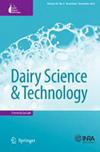Sustainable Approaches in Whey Cheese Production: A Review
Q2 Agricultural and Biological Sciences
引用次数: 6
Abstract
Whey cheeses have been produced from the very early steps of cheesemaking practices as a sustainable way to utilize whey, which is the main by-product of cheesemaking. Traditional whey cheeses, manufactured with similar processes, are Ricotta, Ricotta salata or Ricottone, and Ricotta fresca in Italy; Anthotyros, Myzithra, Manouri, Xynomyzithra, and Urda in Greece; Urda in Serbia and Romania as well as in other countries such as Israel; Lor in Turkey; Anari in Cyprus; Skuta in Croatia and Serbia; Gjetost and Brunost in Norway; Mesost and Messmör in Sweden; Mysuostur in Iceland; Myseost in Denmark; Requeijão in Portugal; and Requesón in Spain and Mexico. The production of whey cheese is based on the denaturation of whey proteins by heating to 88–92 °C. The specific processing conditions and aspects of the microbiology of whey cheeses are discussed. The special characteristics of whey cheeses, which are high pH and high moisture content, make them susceptible to microbial growth. Due to the limited shelf life of these products, extended research has been carried out to extend the shelf life of whey cheese. The sustainable preservation approaches, such as modified atmosphere packaging, addition of herbs and/or plant extracts, and bio-preservation methods are reviewed. Moreover, novel whey cheeses focused on functional properties have developed during the last 10 years.乳清奶酪生产的可持续发展途径综述
乳清奶酪是奶酪制作的主要副产品,作为一种可持续利用乳清的方法,乳清奶酪是从奶酪制作的早期步骤开始生产的。传统的乳清奶酪,用类似的工艺制造,是意大利的乳清干酪,乳清干酪或乳清干酪,乳清干酪;希腊的Anthotyros、Myzithra、Manouri、Xynomyzithra和Urda;乌尔达在塞尔维亚和罗马尼亚以及其他国家,如以色列;Lor在土耳其;塞浦路斯的阿纳里;克罗地亚和塞尔维亚的斯库塔;挪威的Gjetost和Brunost;瑞典的Mesost和Messmör;冰岛的Mysuostur;丹麦的Myseost;葡萄牙的requeij;西班牙和墨西哥的Requesón。乳清奶酪的生产是基于乳清蛋白的变性,加热到88-92°C。讨论了乳清奶酪的具体加工条件和微生物学方面的问题。乳清奶酪的特殊特性,即高pH值和高水分含量,使它们容易受到微生物生长的影响。由于这些产品的保质期有限,因此进行了延长乳清奶酪保质期的长期研究。综述了生物保鲜技术的发展现状,包括气调包装、添加草药和/或植物提取物、生物保鲜等。此外,在过去的10年里,新型乳清奶酪的功能特性也得到了发展。
本文章由计算机程序翻译,如有差异,请以英文原文为准。
求助全文
约1分钟内获得全文
求助全文
来源期刊

Dairy Science & Technology
农林科学-食品科技
CiteScore
2.30
自引率
0.00%
发文量
0
审稿时长
2 months
期刊介绍:
Information not localized
 求助内容:
求助内容: 应助结果提醒方式:
应助结果提醒方式:


